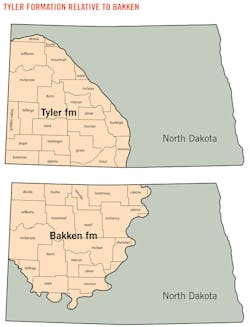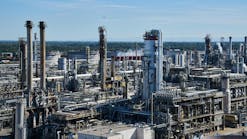In southwest North Dakota, vertical wells in the Tyler formation are typically described as "hit or miss." Marathon Oil has stepped into the region to apply horizontal drilling to the Tyler formation. While results may not be apparent for some time, the North Dakota Geological Society has touted the potential of the play for several years.
Historically, the Tyler formation has been a conventional play. According to Stephan Nordeng and Timothy Nesheim with the North Dakota Geological Survey (NDGS), the Tyler formation contains, in places, good to excellent quantities of organic carbon consisting of kerogen that is prone to generating both oil and/or gas.1 In addition, a significant portion of the Tyler formation is currently within the "oil window" in western North Dakota.
Shortly after Nordeng and Nesheim began publishing reports on the Tyler in 2009, several operators showed interest. In June of this year, Marathon permitted the Rundle Trust 11-29TH wildcat in the southwest corner of state, on the edge of Rocky Ridge oil field. The company made news in October when drilling began. According to data from the North Dakota Industrial Commission (NDIC), Marathon permitted a second horizontal well in October—the Rundle Trust 21-29TH—which is located on the same pad. It is unclear at this early phase whether the wells are development or exploration. Located in Slope County, the company now has four wells permitted for Tyler exploration.
Source: North Dakota Geologic Survey
Field map showing the producing Tyler fields in southern Billings, Slope, and Stark counties. The Initial Production Date (IPD) is given for each field. Fields with evidence of initial fluid overpressure in the Tyler are colored in red, fields that were initially at hydrostatic pressure are colored in blue, and fields that were underpressured prior to production are colored green.
Historic production
Marathon is not the only company that is evaluating Tyler potential. Continental Resources, Whiting Oil and Gas, ExxonMobil subsidiary XTO Energy Inc., Enerplus Resources, and Williston Exploration have cut sample cores of the Tyler, according to sources with NDGS.
Historically, operators have drilled vertically into the Tyler formation. These wells can often be poor performers. Exceptions to this include wells such as Charger Resources LLC's Howie 11X2, which has a cumulative production of 780,771 bbl of oil and still produces 250 bbl per month, according to NDIC. The Howie 2, also in Rocky Ridge field, shows a cumulative production 323,851 bbl.
Source: North Dakota Geologic Survey
The Tyler formation lies above the Bakken and encompasses nearly all of western and southwestern North Dakota and extends into South Dakota.
The Tyler formation has produced oil and natural gas since it was first developed in the 1950s. To date, only 285 wells have been drilled, primarily along the Dickinson-Fryburg Trend in Billings and Stark counties. The Tyler has produced 84 million bbl of oil, averaging 294,000 bbl of oil per well. Production for Tyler peaked in the late 1970s with nearly 3.5 million bbl of oil produced, according to NDGS.
As of this writing, several other operators were moving into the area for horizontal drilling applications. Williston Exploration is active in the northwest end of Rocky Ridge field. While results are still speculative, many members of industry are watching the activity to see what results horizontal drilling and hydraulic fracturing will yield from the Tyler compared to vertical drilling.
Benefits, challenges
The Tyler formation is geologically complex and similar to the Bakken, although it does not share all of the Bakken's potential. With most of the new drilling taking place in Slope County, N.D., successful discovery wells could bring growth to several small towns in the area, including Amidon and New England south of Dickinson.
Just north of Dickinson, in Dunn County, several oil companies have opened offices in the town of Dunn Center. Housing is being developed and the city's downtown is experiencing some revitalization, said Department of Mineral Resources Director Lynn Helms in a recent television interview.
In Hettinger and Slope counties in Southwest North Dakota, where most of the Tyler development is now taking place, rural communities are concerned about water resources. Some communities may begin expanding water resources by adding more water wells and/or above ground storage tanks should drilling activity increase rapidly. Limited water infrastructure will pose a challenge, according to statements from North Dakota's Southwest Water Authority.
Stepping out
With Bakken shale production continually rising, operators are now comfortable stepping out into newer resource areas. Marathon produced 38,000 net boe/d during the third quarter this year. The Tyler formation offers a nearby, low-risk arena for deploying newer, unconventional technologies that were first attempted in the Bakken in the mid-2000s.
Time will tell whether horizontal drilling and hydraulic fracing can improve efficiencies in the Tyler formation. Marathon currently estimates that it can produce 1.6 million boe from its four Tyler wells.
Reference
1. Nordeng, Stephan and Nesheim, Timothy, "The Resource of the Tyler Formation in North Dakota," NDGS, Feb. 15, 2011.



